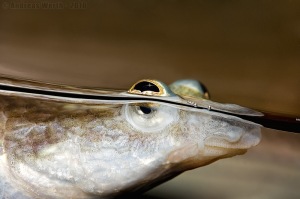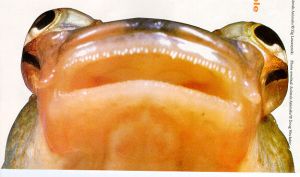In a recent visit to the Mystic Aquarium in Connecticut, I saw beluga whales. I saw Steller’s sea lions. I saw stingrays and sharks and electric eels. But nothing captivated my imagination like the school of homely mudskippers staring out at me from the water’s surface… from both above, and below.
The Four-Eyed Fish (Anableps anableps) of Central and South America does not actually have four eyes, but does indeed have four pupils. Each eye’s two pupils are divided by a span of iris. Four-eyed fish prefer to sit at the surface of a still pool in a brackish mangrove swamp, watching for insects to eat both above and below the water surface, and so their eyes are only half-submerged. The two pupils of each eye, therefore, not only watch the surface from both above and below it, but are calibrated to view both air and water differently. The lenses in the eyes change in thickness from top to bottom to account for the different refractive indices of air and water; as anyone who’s tried stealing quarters from a mall fountain knows, water tends to warp and slow down light when viewed from above, making objects underwater seem out-of-place. The optical illusion persists viewing the airy world from underwater. The four-eyed fish can view both sides without a bent image at all. So, two eyes, four different fields of vision, all blended into one seamless image in the four-eyed fish’s brain. Essentially, it has its own bifocals. Or, better yet, you know that look a teacher gives you over her glasses when you’re really in trouble? The four-eyed fish is that teacher.
Consider for a moment the genius of this adaptation. The four-eyed fish is literally looking into two different worlds at once. Perched at the water’s surface, its eyes half in and half out, it simply splits its vision. Like a medium with half her mind in some spirit realm, it can foresee both fortune and doom, predators and prey from either world with uncanny accuracy.














